The Hidden Life of Trees
Air Date: Week of October 7, 2016
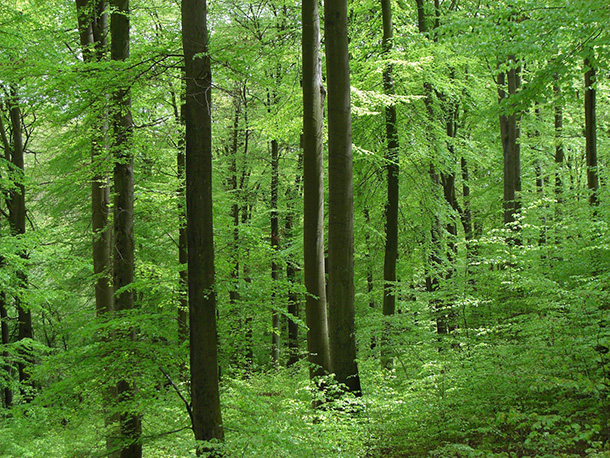
A 4,000-year-old beech forest in Peter Wohlleben’s forest district in Hümmel. (Photo: Peter Wohlleben)
Forests contain much, much more than meets the eye, writes Peter Wohlleben in his groundbreaking book The Hidden Life of Trees. Within the roots of trees are active brain-like processes, and trees are capable of communication and learning. A forester himself, Peter Wohlleben tells host Steve Curwood about the unseen and unsung connections between trees, and how humans can better care for them.
Transcript
CURWOOD: According to Greek mythology, the trees in a certain grove could talk, with the gift of prophecy, and there are many other stories of talking trees, from the Disney film from Pocohontas to the Lord of the Rings. Well now a German forester says trees can talk, at least to each other. Peter Wohlleben also believes forests are social networks where individual trees not only communicate with each other and warn each other of impending dangers, they also care for their sick and elderly and live shorter lives if they can’t connect with each other. Peter Wohlleben’s book is called The Hidden Life of Trees, and he joins me now from Germany.
Welcome to Living on Earth Peter!
WOHLLEBEN: Hi. Hello.
CURWOOD: Now, where is your forest there in Germany?
WOHLLEBEN: My forest is in the western parts of Germany just a little distance to the Belgian border in the Eifel Mountains. We have beautiful forests there.
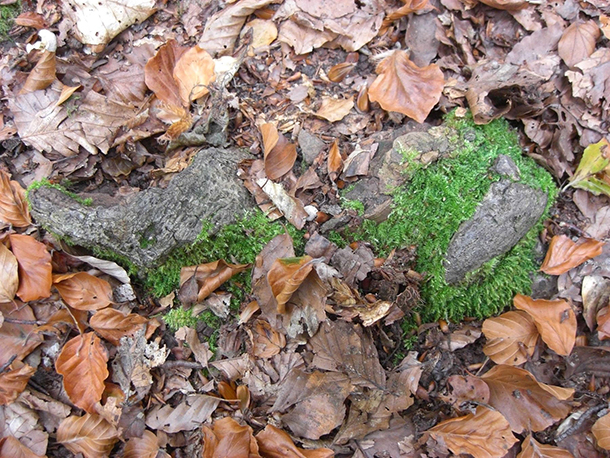
The old moss-covered stump, which Peter Wohlleben first thought was a stone (Photo: Peter Wohlleben)
CURWOOD: So, I want to warn our listeners to strap on their seat belts because we're going to go to some heights of thinking about trees that people usually don't go. We'll talk about trees maybe having brains, having societies, having some sort of a memory. Peter, you began your book with the chapter called “Friendships” that describes how you stumbled upon a rather remarkable set of mossy green, might I say, stones? What did those stones turn out to be?
WOHLLEBEN: They turned out to be a century-old stump. The tree I think was felled 500 or 400 years ago, and when I stumbled upon it and researched it, I found out that it was still living without any green leaf, and that seemed to be impossible because a tree is a living being which burns sugar in its cells, like we do. And after 400 years every molecule of sugar should have been gone, and the only explanation was that this old stump was supported by its neighbors.
CURWOOD: Supported by its neighbors? Why do some trees feed a nearby stump?
WOHLLEBEN: Yeah, that sounds incredible because we all learned in school that within evolution each being is struggling against each other so that just the fittest survive, but in the forest we have a social society which fights for each other so the whole forest will survive. Every tree is interested to keep its neighbors because together they create a special climate which is cool, which is humid, where every tree feels comfortable.
CURWOOD: By the way, what kind of tree was this stump?
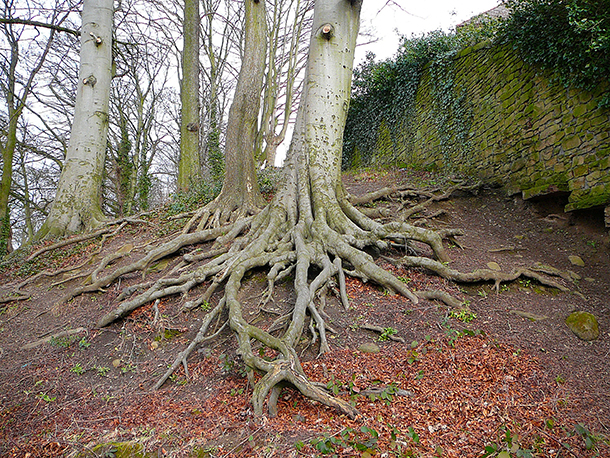
Tree roots are believed to contain a great deal of a tree’s accumulated ‘knowledge’ (Photo: Tim Green, Flickr CC BY 2.0)
WOHLLEBEN: The stump is an old Beech tree. Beeches were common to all Germany, to all Central Europe into the eastern part of the United States and to some parts of Canada. Nowadays we have most of those areas changed into plantations of Spruce and Pine and so on.
CURWOOD: So, if this stump was some 400 years old, how old were the trees that were taking care of it?
WOHLLEBEN: We don't know because these trees weren't planted, so just can guess how they are. I think they are about 200 years old. We don't have any very old trees in Germany because each tree, when it gets a certain age, will be felled. So, the timber industry, that's a very sad chapter, and without very old forests we can't detect what's going on.
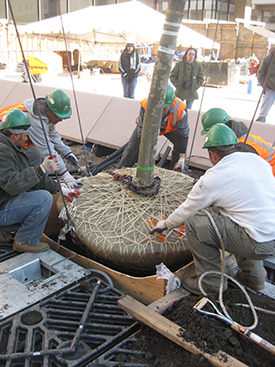
By necessity, the roots must be cut when the tree is planted; but this practice, among other factors, shortens the life of urban trees. (Photo: DeepRoot, Flickr CC BY-NC-ND 2.0)
CURWOOD: In your book you imply that there must be some relationship between that stump and the trees that are feeding it. Maybe family?
WOHLLEBEN: Yeah, that's really possible. Susan Simard from the University of British Columbia found out that, for example, mother trees are able to detect their childs from other young trees, and that they are also have favorite childs which they feed more than other childs, which sounds incredible and perhaps even not so nice, but that's something which even trees have.
CURWOOD: What do you think the odds are that the trees around it were daughters or sons of this mother or father, that they were taking care of their parent?
WOHLLEBEN: That's possible because trees, they have in their root tips, brain-like structures. The University of Bonn found that brain-like processes are going on so that the trees can manage to find out, is it a neighbor, is it a different species, are that are my own roots or is a beloved child or grandfather or whatsoever?
CURWOOD: OK, wait a second. You're talking about brains in trees. How could a tree have a brain?
WOHLLEBEN: Yeah, that's really something special because it's not a brain like we have, and that makes it a little bit complicated to understand because we really don't know exactly where the brain of the tree is. We know that the root tips have brain-like structures, but that doesn't mean that the brain is there. We don't know where a tree stores its memories, for example. Some memories are stored in the branches. We know that, for example, in spring trees can count the days above 20-degrees Celsius because when it's getting warm in March that doesn't mean that the spring is really there.
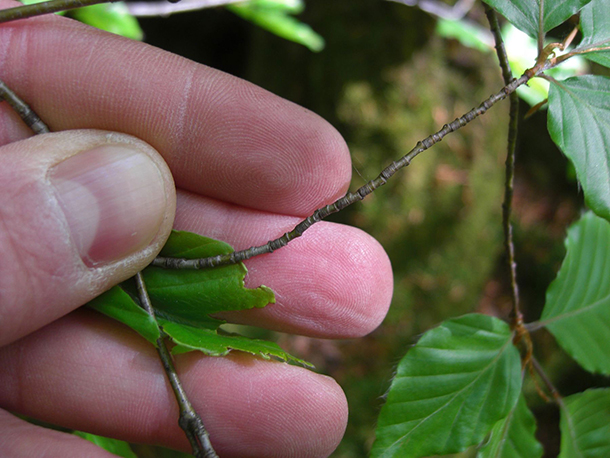
A branch from a little beech tree. Each knot on the bark represents one year of growth and shows how slowly the young tree is growing. (Photo: Peter Wohlleben)
There may be some days after, for example, in April where deep frosts can destroy the new leaves, so the trees have to wait until the spring is really there, and therefore they count the days, the warm days and just when a certain amount is counted, then the new leaves appear, and that means that a tree do not just count but also has a memory. Trees can also remember, for example, heavy droughts. In the year 2003, we had in Germany a very heavy drought during the summertime, and trees which were not used to dry summers, they suffered very hard. The wood cracked, and that hurt them, and afterwards those trees changed their strategy of water consumption. They know that they don't have to use too much water in spring because they had to save some water for the next maybe dry summer. So, a tree can remember what has been going on in the past and after that change its strategies to a new way of water consumption, and that was something very surprising.
CURWOOD: So you're saying that trees are capable of learning, and you wrote that in your book. What do you mean?
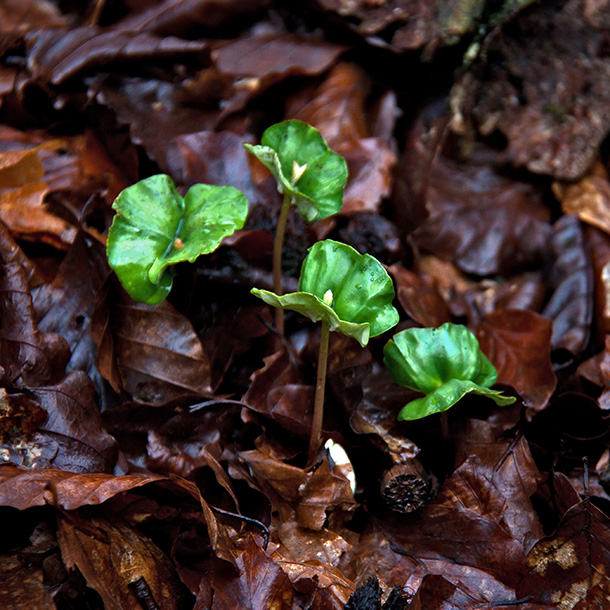
Beech seedlings (Photo: Mark Robinson, Flickr CC BY-NC 2.0)
WOHLLEBEN: Yeah, trees are also able to learn from other trees, for example, this case of this heavy drought. It concerns at first trees which are standing on dry earth. They are the first ones to suffer from a drought, and, when they recognize that the water is running out, then they give information to other trees through their roots and through a family network and those other trees learn that there is something going on with a drought or with an insect attack, and then they can prepare and reduce their water consumption, or, when an insect attack is going on, they may bring poison into their bark and they store this memory, and the next situation like this they may react much faster.
CURWOOD: How do trees communicate? How fast does that communication go?
WOHLLEBEN: Trees are very slow. For example, electrical signals in their tissue needs perhaps one or two second per inch. Therefore, they may react within minutes or hours or even days. Because this electrical signal will use maybe several minutes from the upper tree down to the roots, there's a second way to communicate with chemical signals which are sent out from the leaves, and the trees around may smell it, and therefore smell, “Ah, this is a special beetle which is attacking the neighbor tree.” And they may prepare much faster than being informed through the roots.
CURWOOD: So electrical impulses travel through the trees very slowly, but rather the way nerves transmit things, and they can warn each other of danger. Peter, why is it useful for forest managers to understand trees as social beings?
WOHLLEBEN: Because healthier forests will also produce more timber. But for me the main thing is foresters should be treekeepers, and the first aim should be to keep a healthy forest for the next generations. The forest is much more than timber, for example, this old Beech forest which I'm responsible for contains more than 10,000 animal species, and when you clear-cut it and replace it, for example, with a Douglas Fir or a Spruce, then most of those species will be run out and replaced by species which are not common to our region.
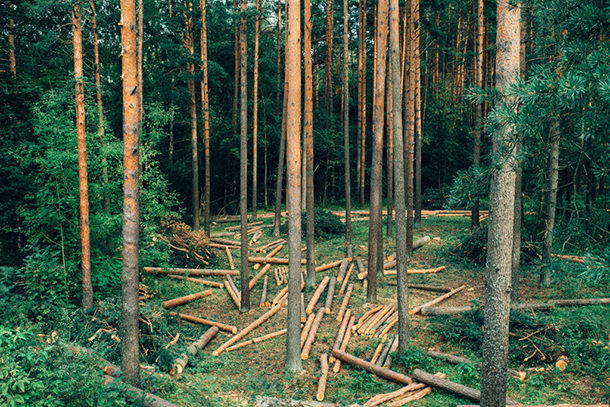
Even selective logging (as opposed to clear cutting) harms forests, according to Wohlleben. (Photo: barnimages.com, Flickr public domain)
CURWOOD: Peter, what is lost when old growth is cut? How does that change the behavior in the social network of trees?
WOHLLEBEN: Even when you make a thinning and just cutting one of the other trees and leave, for example, 50-percent of the trees untouched, this social network is destroyed. When you do it like this, you makes a tree changing from a social being to single. Those trees suffer. They don't get very old. For example, a Beech may grow as old as 400 years and when you make a thinning in such a forest, this Beech will die at around 200 years, nearly half the age which is natural.
CURWOOD: Peter, how are urban trees very different from the trees that have grown up in a forest?
WOHLLEBEN: Urban trees are a special thing. Urban trees are like street kids without parents. They can grow as they want to grow, and in a metro forest, in a primeval forest, those old mother trees didn’t rely down to like 3-percent, so the little ones may produce just as much sugar that they don't die, but not more. They are not allowed to grow in the first 200 or 300 years. In the street, they get from the first day on light as much as they want.
They can grow, they can produce sugar as much as they want and they grow in a very unhealthy way, very, very fast. That's what we want to have in our streets. We want to have in a short time big trees because they look so nice, but those trees can’t become very old. They will die earlier. There is another problem. When you let the street light burn the whole night, then trees can't sleep, and they will die earlier that trees which may sleep at night without any light.
CURWOOD: So, in Boston where we have our studios, up and down the streets there are not a lot of very old trees even through the streets are very old. What would've happened to those trees to prevent them from getting to be old? After all, they're protected in the city. No one is likely to cut them down, unless there's a storm or something.
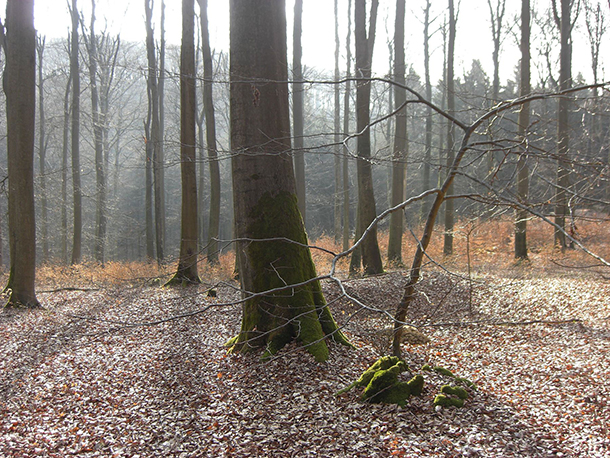
A 200-year-old mother beech tree with its 150-year-old child (Photo: Peter Wohlleben)
WOHLLEBEN: Yeah, but they are without their social network. Those trees are all singles. They are all on their own like Robinson Crusoe on an island. We think we have, for example, in the street a row of trees which should be connected but in reality the distances are too far. The roots are destroyed. The root tips, they have been cut, because otherwise the roots were too big to plant. And with those cutted roots, the trees are not able to connect anymore.
CURWOOD: When did you realize that individual trees can communicate with each other, care for their sick, warn each other of impending dangers?
WOHLLEBEN: I think, the first time, I knew about trees as much as a butcher about animal feelings. But afterwards, to rescue the old Beech forest, we made part of them into a burial ground. People may buy an old Beech tree instead of a gravestone and be buried in form of an urn, and together with those people I learned to look new at trees. As a forester, you see a tree and every tree planks or you see paper or whatsoever. Then, when I began to look more and more, I discovered more which makes it nowadays a little heavy to cut any trees which I have to do.
CURWOOD: I imagine. Peter, how are people reacting to your research?
WOHLLEBEN: Most people are reacting friendly because I just write things which they always thought might be true, but really, bad critics are coming from foresters, and think, I believe it's because I disturb their jobs, their profits, because when people register the trees have feelings then we can't treat them like we do nowadays, with cheap methods, for example, by harvesting those trees with big machines, destroying with those heavy machines the storage possibilities of the soil by compressing the soil and so that no water may be stored from the winter. So it's true that most bad critics are coming from colleagues from me, and applause is coming from, let's say, normal people which always thought there has to be more than just timber from trees.
CURWOOD: Overall, how well are we doing managing the forests on our planet here on Earth?
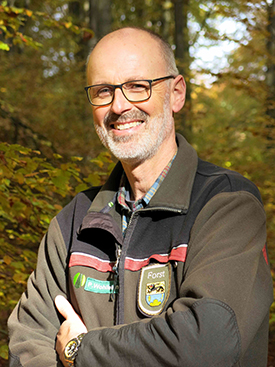
Peter Wohlleben is the author of Hidden Life of Trees: What They Feel, How They Communicate – Discoveries from a Secret World (Photo: Tobias Wohlleben)
WOHLLEBEN: I think we are treating them very bad in the moment. For example, those clear-cuts are not just destroying those social systems, but also the factories for wood. When you cut a forest complete down, you have nothing to produce timber. We have changed here in this little village where I'm living, the forest methods, and afterwards we have created more jobs, we have earned much more money, and the forest is healthier. So, we have ways to use timber without disturbing the forest too much. Trees which can get very old store carbon at the same time, that's clear. But in the moment, all I see is the fast profits. There's no thoughts about the future and the next generations.
CURWOOD: Peter Wohlleben is a forester and author who cares for an environmentally friendly woodland for the village of Hummel in Germany. His new book is called "The Hidden Life of Trees". Thank you so much.
WOHLLEBEN: Thank you very much.
Links
About Peter Wohlleben’s work as a forester in Hümmel, Germany
The Ancient Beech Forests of Germany comprise a UNESCO World Natural Heritage site
Living on Earth wants to hear from you!
Living on Earth
62 Calef Highway, Suite 212
Lee, NH 03861
Telephone: 617-287-4121
E-mail: comments@loe.org
Newsletter [Click here]
Donate to Living on Earth!
Living on Earth is an independent media program and relies entirely on contributions from listeners and institutions supporting public service. Please donate now to preserve an independent environmental voice.
NewsletterLiving on Earth offers a weekly delivery of the show's rundown to your mailbox. Sign up for our newsletter today!
 Sailors For The Sea: Be the change you want to sea.
Sailors For The Sea: Be the change you want to sea.
 The Grantham Foundation for the Protection of the Environment: Committed to protecting and improving the health of the global environment.
The Grantham Foundation for the Protection of the Environment: Committed to protecting and improving the health of the global environment.
 Contribute to Living on Earth and receive, as our gift to you, an archival print of one of Mark Seth Lender's extraordinary wildlife photographs. Follow the link to see Mark's current collection of photographs.
Contribute to Living on Earth and receive, as our gift to you, an archival print of one of Mark Seth Lender's extraordinary wildlife photographs. Follow the link to see Mark's current collection of photographs.
 Buy a signed copy of Mark Seth Lender's book Smeagull the Seagull & support Living on Earth
Buy a signed copy of Mark Seth Lender's book Smeagull the Seagull & support Living on Earth

